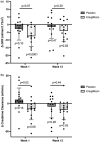Mechanistic evaluation of ertugliflozin in patients with type 2 diabetes and heart failure
- PMID: 40207988
- PMCID: PMC11983784
- DOI: 10.14814/phy2.70275
Mechanistic evaluation of ertugliflozin in patients with type 2 diabetes and heart failure
Abstract
The effect of sodium-glucose cotransporter-2 (SGLT2) inhibitor ertugliflozin on fluid volume and kidney function was assessed in patients with type 2 diabetes and heart failure. Thirty-four participants were randomized in this double-blind, placebo-controlled, parallel-group, multicenter study. Physiologic measurements were obtained under clamped euglycemia at baseline, 1 week, and 12 weeks of treatment. The primary outcome was the proximal tubular natriuretic effect of ertugliflozin versus placebo, measured by fractional excretion of lithium (FELi). Ertugliflozin did not increase FELi or total FENa at 1 week or 12 weeks. Ertugliflozin increased both mean 24-h urinary sodium excretion (47.5 ± 22.1 mmol/day vs. placebo, p = 0.032) and urinary volume (p = 0.009) at 1 week, which was attenuated at Week 12. Reductions in extracellular fluid (-1.9 ± 0.8 L, p = 0.01), estimated plasma volume (-11.9 ± 13.9%, p = 0.02), and supine mean arterial pressure (-6.6 ± 2.7 mmHg, p = 0.02) were significant at Week 12. Compared to placebo, ertugliflozin acutely increased circulating angiotensinogen and angiotensin-converting enzyme (ACE) levels, as well as urine adenosine and ACE2 activity (p < 0.05). Changes in other neurohormones, sympathetic activity, kidney, and systemic hemodynamics did not differ compared to placebo. Our findings suggest that SGLT2 inhibition shifts systemic volume toward a state of euvolemia, potentially lowering the risk of worsening heart failure.
Keywords: SGLT2 inhibition; ertugliflozin; heart failure; type 2 diabetes.
© 2025 The Author(s). Physiological Reports published by Wiley Periodicals LLC on behalf of The Physiological Society and the American Physiological Society.
Conflict of interest statement
DZIC has received honoraria from Boehringer Ingelheim–Lilly, Merck, AstraZeneca, Sanofi, Mitsubishi–Tanabe, Abbvie, Janssen, Bayer, Prometic, BMS, Maze, Gilead, CSL–Behring, Otsuka, Novartis, Youngene, Lexicon, and Novo–Nordisk and has received operational funding for clinical trials from Boehringer Ingelheim–Lilly, Merck, Janssen, Sanofi, AstraZeneca, CSL–Behring, and Novo–Nordisk. VSS is supported by the Department of Medicine Eliot Phillipson Clinician Scientist Training Program and a Banting and Best Diabetes Centre Postdoctoral fellowship at the University of Toronto. VSS has received conference and travel support from Merck Canada. YL, LK, LEL, and EMB have no conflicts of interest to disclose. DHvR has acted as a consultant for and received honoraria from Boehringer Ingelheim–Lilly Diabetes Alliance, Merck, Sanofi, and AstraZeneca and has received research operating funds from Boehringer Ingelheim–Lilly Diabetes Alliance, AstraZeneca, and Merck (all honoraria transferred to employer Amsterdam UMC). The employer of AAV received consultancy fees and/or research support from Adrenomed, Anacardio, AstraZeneca, Bayer AG, BMS, Boehringer Ingelheim, Corteria, Eli Lilly, Merck, Moderna, Novartis, Novo Nordisk, Roche Diagnostics, and SalubrisBio.
Figures






References
-
- Burns, K. D. , Lytvyn, Y. , Mahmud, F. H. , Daneman, D. , Deda, L. , Dunger, D. B. , Deanfield, J. , Dalton, R. N. , Elia, Y. , & Har, R. (2017). The relationship between urinary renin‐angiotensin system markers, renal function, and blood pressure in adolescents with type 1 diabetes. American Journal of Physiology‐Renal Physiology, 312, F335–F342. - PubMed
-
- Cannon, C. P. , Pratley, R. , Dagogo‐Jack, S. , Mancuso, J. , Huyck, S. , Masiukiewicz, U. , Charbonnel, B. , Frederich, R. , Gallo, S. , Cosentino, F. , Shih, W. J. , Gantz, I. , Terra, S. G. , Cherney, D. Z. I. , McGuire, D. K. , & Investigators, V. C. (2020). Cardiovascular outcomes with Ertugliflozin in type 2 diabetes. The New England Journal of Medicine, 383(15), 1425–1435. 10.1056/NEJMoa2004967 - DOI - PubMed
-
- Cherney, D. , Dekkers, C. , Barbour, S. , Cattran, D. , Abdul Gafor, A. , Greasley, P. , Laverman, G. , Lim, S. , Di Tanna, G. , & Reich, H. (2020). Effects of the SGLT2 inhibitor dapagliflozin on proteinuria in non‐diabetic patients with chronic kidney disease (DIAMOND): A randomised, double‐blind, crossover trial. The Lancet Diabetes and Endocrinology, 8, 582–593. - PubMed
-
- Cherney, D. Z. , Miller, J. A. , Scholey, J. W. , Bradley, T. J. , Slorach, C. , Curtis, J. R. , Dekker, M. G. , Nasrallah, R. , Hebert, R. L. , & Sochett, E. B. (2008). The effect of cyclooxygenase‐2 inhibition on renal hemodynamic function in humans with type 1 diabetes. Diabetes, 57, 688–695. - PubMed
-
- Cherney, D. Z. , Perkins, B. A. , Soleymanlou, N. , Maione, M. , Lai, V. , Lee, A. , Fagan, N. M. , Woerle, H. J. , Johansen, O. E. , Broedl, U. C. , & von Eynatten, M. (2014). Renal hemodynamic effect of sodium‐glucose cotransporter 2 inhibition in patients with type 1 diabetes mellitus. Circulation, 129, 587–597. - PubMed
Publication types
MeSH terms
Substances
Grants and funding
LinkOut - more resources
Full Text Sources
Medical
Miscellaneous

